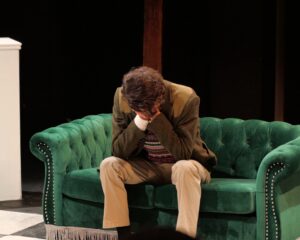On Feb. 17, Dr. Herman Haller, the president of MDI Biological Laboratory, gave a virtual Arts and Humanities in Medicine lecture via Zoom titled “Medical Rounds in the Museum: Representation of Science and Medicine in Paintings.” This event was organized by the Intermedia Programs and the University of Maine Institute of Medicine.
Dr. David Harder, who has his Ph.D. in biophysics and is the lead professor of the Institute of Medicine at UMaine, hosted this event.
This lecture explained the relationship between medicine and art, and how often times throughout history, disease and other medical complications were represented in art. Haller kicked off the lecture by using the well known painting “The Mona Lisa” by Leonardo da Vinci as his first example. He theorized that Mona Lisa could have suffered from hypothyroidism, with the symptoms represented in the painting being edema in the hands and neck, thinned hair and yellowing of the skin which Haller explains could be xanthelasma, a tell-tale sign of high cholesterol.
Another interesting example that Haller used is in a painting named “The Blind Leading the Blind” by Pieter Brugel. This painting features five men with five different ocular diseases.
Going from left to right, Haller explained that the first man likely suffered from pemphigus. The lesions on the man’s face suggested that he suffered from this autoimmune disease that affects the skin and mucous membranes such as the eyes. The next man likely has cataracts or photophobia as his hat seems to be arranged in a way that allows him to keep the sun out of his eyes. The man positioned to the right of him in this painting seems to have ocular atrophy, possibly as a result of glaucoma. Next, there is a man who Haller explains could be suffering from keratitis. The evidence pointing to this is that he is depicted with red, irritated and murky eyes. Lastly, the man in front of the others is shown stumbling over the man who fell in front of him. He seems to have no eyes at all, indicating that he underwent enucleation, likely as punishment for a crime.
The variety of diseases depicted in “The Blind Leading the Blind” is an interesting way to see how disease was viewed centuries ago and to take a look at what a medical painting looked like in the 1500s.
“Medical Rounds in the Museum: Representation of Science and Medicine in Paintings” offered a unique perspective on how two worlds colliding can come together in a way that both fields of study can complement each other nicely. This lecture clearly expressed the principle that art can help create a better understanding of science and science can help create a better understanding of art.
Augusta Farnum, an artist who helped organize this event, described the goal of this program.
“The program sits squarely at the intersection of art and medicine, looking at, listening to and engaging the ‘edge effect’ of these diverse whole systems of knowledge. The core of the virtual program is a seminar, with guest lectures from across the nation. This year the students will be engaging in public projects that stem from the work in class. While there are programs across the globe examining this art and medicine work, the program is unique as it brings artists and medical providers to the same table. Next year the Institute of Medicine will be providing at least two fellowships one for an artist and one for a physician,” Farnum said.
If you are interested in this program you can visit, https://intermedia.umaine.edu/application-process-2/ to learn more.










